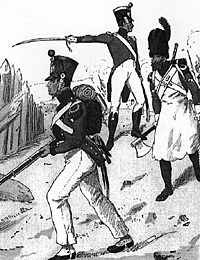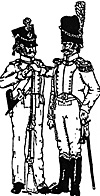Editor's Note: The story of the Swiss regiments serving in the French Army started with the Valais Battalion in EE&L #10. We complete the study here with the uniform and history of the only other Swiss unit to serve Napoleon.
The "Bataillon du Prince de Neufchâtel" or, more usually the "Bataillon de
Berthier de Neufchâtel" was raised following an Imperial decree of 11 May 1807. The decree detailed the organization of the battalion as a light infantry unit with a Staff of eight
(including the Chef de Bataillon commanding) and six companies (one carabinier, one voltigeur and four chasseurs) each of 160 officers and men.
Command
Command of the battalion was given to Captain
Jean Henri de Bosset, an experienced officer and a native of the Principality,
with the promotion to Chef de Bataillon. Recruitment was
swift and the two elite companies were complete by 1 August, and
seven days later the chasseurs cadres were also complete. The
Battalion depot was fixed at Besançon.
On 26 March 1808 the Battalion was assigned to the 7th Division of the coastal guards at Le Havre, their role to prevent the continual raids of the British Navy. On 27 August 1808 a new Imperial Decree created an artillery company to be attached to the Battalion. This was commanded by Captain de Perrot and had an establishment of 82 officers and men with two
six-pounders, [4] three artillery caissons, and one ammunition wagon. In October the Battalion Staff was increased by one with the
appointment of a Drum Major.
The Neufchâtel Battalion remained at Le Havre until April 1809 when with the outbreak of hostilities with Austria they were summoned to join the Grand Army. The Neufchâtel joined the Army on 24 May at Ebersdorf [5] and saw their first real action twelve days later at the culminating battle of Wagram.
In the Grand Army's Order of Battle for Wagram the Neufchâtel Battalion was in the suite of Marshal Prince Berthier with a strength of 703 officers and men. [6] During the battle, the Battalion was assigned the task of guarding the bridge from
the Isle of Lobau but somehow seems to have been swept up into a final general attack in which Lasalle was mortally wounded.
After the close of the Campaign, the Battalion returned to its depot at Besançon but not for long. On 18 January 1810 the Neufchâtel was at Bayonne en route for Spain, and on 7 February it was at Burgos under the command of General Dorsenne and attached to the Young Guard.
In Spain
On 9 December, de Bosset was promoted Colonel and Captain de Gorgie was promoted Chef de Bataillon to command the Neufchâtel Battalion.
During March 1812 the Battalion was recalled from Spain to participate in the Russian Campaign and, as in 1809, was attached to Imperial Headquarters. As a "support" battalion, the Neufchâtel remained at Smolensk when the Grand Army departed for its final push on Moscow and only rejoined during the retreat. The only actions the Battalion saw during the campaign was at Krasnoe on 17 November and at the Beresina on the 27th, but on neither occasions was it heavily involved. Campaign attrition (disease and straggling) was to be the destroyer of the Battalion as it was of most of the Grand Army.
1813
In 1813 the Battalion was yet again the Imperial Headquarters guard and so avoided the early
pre-armistice actions. Nonetheless, at Leipzig, the Battalion was heavily involved with no less than six officers killed (27% of the establishment). [8] The remnants of the Battalion were later in action at Hanau but thereafter the Battalion was dispersed into various besieged garrisons, and elements were in Metz, Toul, and, of course, Besançon. Effectively the Neufchâtel had ceased to exist and the formal disbandment took place on 1 June 1814 with the survivors being drafted into the Imperial Guard.
Uniform of the Neufchâtel Battalion
[1] Louis Alexandre Berthier, 1753-1815, Napoleon's Chief of Staff until 1814 and since the Italian campaign of 1796. In 1806 the Swiss principality of Neufchâtel was attached to France and on 30 March of the same year Berthier [1] was created Prince of Neufchâtel, on the sole condition that he should marry. [2] Berthier was the first of Napoleon's Marshals to be given a Royal title. [3] Although the new Prince was never to visit his Principality, he provided for its government through one of his close friends - General Dutaillis.
In 1806 the Swiss principality of Neufchâtel was attached to France and on 30 March of the same year Berthier [1] was created Prince of Neufchâtel, on the sole condition that he should marry. [2] Berthier was the first of Napoleon's Marshals to be given a Royal title. [3] Although the new Prince was never to visit his Principality, he provided for its government through one of his close friends - General Dutaillis.
 Sometime in October 1810 the Battalion moved to Salamanca to protect the communications of Claparède's Division to which it had been transferred. It was then assigned to Thièbault's Division garrisoned there, in which it was engaged at Aldeia on 27 September 1811 -its only formal action during its time in Spain. The rest of its time was spent in the interminable anti-guerrilla actions which characterized the Peninsular War for many French units.
Sometime in October 1810 the Battalion moved to Salamanca to protect the communications of Claparède's Division to which it had been transferred. It was then assigned to Thièbault's Division garrisoned there, in which it was engaged at Aldeia on 27 September 1811 -its only formal action during its time in Spain. The rest of its time was spent in the interminable anti-guerrilla actions which characterized the Peninsular War for many French units.
 Only 3 officers and 110 men remained with the Battalion on its arrival at the depot at Besançon and the process of rebuilding was commenced with the drafting of 428
young recruits from the Principality [7] during the first months of the New Year.
Only 3 officers and 110 men remained with the Battalion on its arrival at the depot at Besançon and the process of rebuilding was commenced with the drafting of 428
young recruits from the Principality [7] during the first months of the New Year.
Color Plates of Uniform of the Neufchâtel Battalion (very slow: 252K)
Footnotes
[2] See R. Dunn-Pattison Napoleon's Marshals, London 1909, p.12. Berthier didn't, in fact, marry until Tilsit in 1807. See also EE&L #4, pp 16-17.
[3] Bernadotte was next when he was made Prince of Pontecorvo on 5 June. Murat, Napoleon's other constant comrade, had been created Grand Duke of Berg on 15 March, 1806.
[4] These must have been either of the Year XI system or captured Austrian weapons - the former most likely. The older Gribeauval system did not include a six-pounder.
[5] It is at this time that the nickname of "The Canaries" is first recorded, although they may already have been called that in Le Havre.
[6] Armies on the Danube, 1809, Scott Bowden and Charles Tarbox, The Emperor's Press, Chicago, 1980. Berthier's suite included the 3rd and 4th squadrons of the 26th Chasseurs á Cheval and the 3rd squadrons of the 10th and 22nd Chasseurs á Cheval.
[7] The first non-Swiss recruits had been accepted by the Battalion in 1809 but the rebuilding was mainly effected with natives of Neufchâtel.
[8] Sadly I have no record of the losses of other ranks or of the wounded.
Back to Empires, Eagles, & Lions Table of Contents #12
Back to Empires, Eagles, & Lions List of Issues
Back to MagWeb Master Magazine List
© Copyright 1995 by The Emperor's Press
This article appears in MagWeb (Magazine Web) on the Internet World Wide Web.
Other military history articles and gaming articles are available at http://www.magweb.com